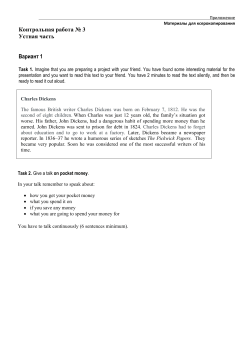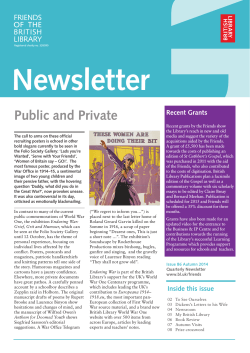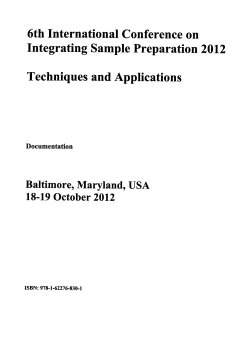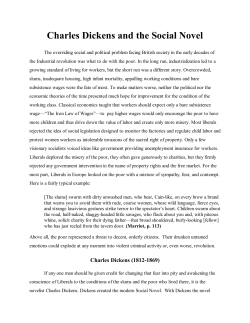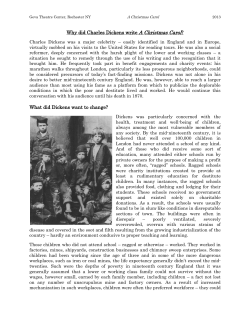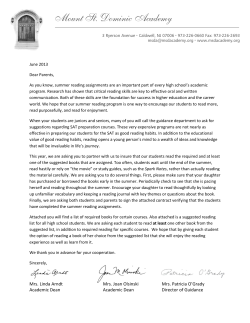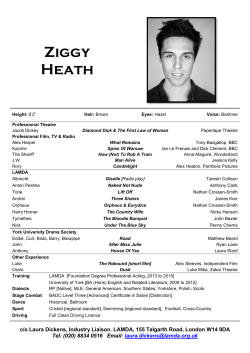
Dickens as a Historian - SNHU Academic Archive
Elizabeth Holland Charles Dickens is universally noted as one of the most influential British authors of the nineteenth century. During his career he published a number of works that are today recognized as classics. Each of Dickens’s most well-loved novels works to criticize the social constructs and issues of England during the nineteenth century. These satirical and brutally honest commentaries on society allowed him to “maintain popularity with the public throughout all phases of his career” (Harris 157). Dickens housed much of his inspiration for his work within the city of London itself. By passage of each of his novels he zoned in on the successes and failures that the city was undergoing. In Dickens’ novels Bleak House, Great Expectations and Oliver Twist, Dickens uses the way in which he publishes his work, the advertisements found within the pages of his novels, and the content of the novels themselves to create a historically accurate representation of nineteenth century London. Throughout the creation of Bleak House, Great Expectations, and Oliver Twist, Charles Dickens established an exclusively London-driven persona around each of his works. He did this by having an unmistakably truthful understanding of the world around him and an overactive awareness of his audience. Throughout this novel, Dickens proved to be as “crucial as an historian of London” (Tambling 166). Through his writing, he was not only able to educate Londoners about the ugly hidden truths of the city but was inadvertently able to introduce and define this city to twenty first century readers. He used the time in which he was writing to illuminate the trials and tribulations that his audience was currently facing. Through his writings, he was able to define the social classes of London, the court systems, and the citizens of nineteenth century London. The financial economy of London, England, during the time that Bleak House, Oliver Twist, and Great Expectations was being published played a large role in the way in which Dickens decided to release his work to the public domain. At this point in time, London was known as the “Capital of the Nineteenth Century” (Horowitz 112). London was noted for the overwhelming diversity in the social classes that it housed. Over the establishment of this power, the city of London became home to the rich, middle, and poor classes. Even though there were a variety of social standings represented during the 1900s, a total of 30% of Londoners lived under the poverty line, thus allowing them to hold an influential role in the London economy. Dickens took this statistic into account while publishing his novel. He had a firm understanding that for his novel to create a large following he would have to produce his work at a cheaper rate. Therefore he began to write serially. During the Victorian Era the serialization of novels was very popular. Charles Dickens became ringleader of releasing work in serialized form with his creation of Pickwick Papers. The Pickwick Papers began making their appearance in April 1836 and acquired completion in November 1837. This was the first time that Dickens experimented with serial fiction. The Pickwick Papers were released incrementally over twenty months through the realm of a literary magazine. It turned out that readers quickly began religiously following Dickens’s thirty-two page narratives month after month. At the time of Dickens’s publication, this was a new and modern way to distribute literary work. “By the time of Queen Victoria's coronation in 1837, the Pickwick Papers were selling up to 40,000 copies a month” (Steinlight 133). After the completion of the Pickwick Papers serialization became “the dominant publishing format for the Victorian era” (Chavez 791). The success that followed Pickwick Papers swayed Dickens to continue to release his work in installments. Dickens published an extensive list of serial fiction, including Nicholas Nickleby, Martin Chuzzlewit , Dombey and Son, David Copperfield , Bleak House , Little Dorrit , and Our Mutual Friend. The success was large enough to allow Dickens to continue to write as a profession. This publication forum established a large crowd because the installments were affordable to the everyday Londoner. Due to the affordability serial publication had the ability to extend the reading community amongst a variety of social classes. This type of publication was able to reach people of all different social standings because the installments of serialized works were comparably inexpensive. They were inexpensive compared to novels that were being printed as a whole during this time. For example, Dickens’ first installment of Bleak House cost the consumer one shilling compared to the twenty-one shillings that a typical book would cost (Brattin 1). This allowed people of both the lower and upper classes to be able to afford the installments. Serial publication was also exceedingly cost efficient for the author as well. It proved to be cheaper because of the lack of hardcover binding that it encompassed. The financially commendable access to the installments of Bleak House allowed for all different people to be indulged in the same literary circle. Before this type of publication, it would be very uncommon for multiple classes to have the access to the same literary works. Before the publication of serial novels it was very difficult for lower class citizens to have access to literary works. This type of publication was exceedingly positive to these readers. Therefore it seems ironic that this overwhelmingly popular way to publish text was being criticized. Due to this criticism, it can be suggested that the thought of more people reading and becoming knowledgeable could be considered threatening to the upper-class society of London. Members of the higher social classes were not use to everyone having access to the same novels and information; therefore, their higher stature was becoming endangered. That is one possible reason for critics like the reviewer from The Idler, and Breakfast-Table Companion to find fault in this type of publication. In the original installments of Charles Dickens’s novel Bleak House, there were typically around sixteen pages of advertisements. These advertisements had a wide range of content. The advertisements included clothes, services, and other novels that were popular during this time. In each monthly installment of Bleak House the advertisements varied. Dickens himself was the one who researched the ads and decided which ones he would like to display in each installment. His decisions regarding which advertisements he would feature in his work had to do with the consumers of his installments. He focused on ads that he believed would relate most to the readers of Bleak House. Dickens was able to select successful advertisements for his consumers because he was“ a brilliant observer of the city” (Burke 659) and had a strong set of awareness on what would be effective to his audience. Along with the advertisements of clothes that were appearing in Bleak House Dickens also worked to give publicity to periodicals. In the second installment of Bleak House on page four of the advertisements, there is an ad for The Law Review; quarterly Journal of British And Foreign Jurisprudence. This advertisement describes what type of information that can be found in the quarterly journal. The mission of this journal is to support the free transfer of land, limit liability in partnership and also to establish a minister of justice (Bleak House No 2. 4). It was crucial for the advertisement to state what could be found in the quarterly so that the consumers could have an understanding about what was in the journal. This advertisement would be applicable to the readers of Bleak House because these were concerns that were arising in nineteenth century London and in the content of the novel. In Emily Steinlight’s article, Anti-Bleak House Advertising and the Victorian Novel, she writes to dissect the advertisements that were published in Bleak House and the other fifteen serial novels written by Dickens. After researching the advertisements, she believed “that what takes place in the serial novel itself has much to do with what takes place in the advertising section from which it remains strategically separate” (Steinlight 136), thus meaning that it is apparent that the content of the novel also coincides with the advertisements that are found within the installments. This is especially recognized in the The Law Review: Quarterly Journal of British And Foreign Jurisprudence advertisement because Dickens’s novel revolves around a Chancery Court Case. Therefore, the readers prove to have some form of interest in the law and what is going on in the judicial sphere of London thus making sense for Dickens to include an advertisement that was related to law. In the second installment of Bleak House, there is an advertisement for The Dictionary of Domestic Medicine and Household Surgery. This is another advertisement supporting the publication of a periodical. This periodical worked to create a list of illnesses that were the cause of many diagnoses in London. It was a guide that was being published in three separate parts. Within these sections, the author offered emergency procedures that one could do in order to fight the illness that they were enduring in their own homes. This periodical would be helpful to many of the readers because it was exceedingly common for them to fall ill with some of the sickness described in the periodical. It is also noted that The Dictionary of Domestic Medicine and Household Surgery was extremely relevant to both the novel and the world of London in the Victorian Era. In Bleak House there are many characters that fall ill over the course of the novel. The illnesses that these characters faced were based off of sickness that were plaguing London at the time the novel was written. Therefore, any further information on these illnesses would be helpful for the reader to not only understand the sicknesses in the novel but for their own wellbeing. Dickens also sought out inspiration in his work in regard to the diseases that were being uncovered during the time in which he was writing. In London, during the nineteenth century, the city was completely disease ridden. People were being infected in large numbers from Smallpox, Tuberculosis, Cholera and a variety of other seemingly untreatable illnesses. Many of these diseases were becoming even more apparent due of the lack of hygiene and clean supplies that occupied London. Even though all of these diseases were extremely life threatening they ultimately affected the rich and the poor in different manners. Throughout Bleak House Dickens deliberately worked to illuminate the differences that were notable between the rich and the poor while they contracted the same sicknesses. He incorporated these aspects into his novel because they were conflicts that most of his audience members were enduring. Smallpox is the most prominent disease that is found within the pages of Bleak House. Smallpox is a viral infection that appears on the body in rash form. The rash “occurs all over the body starting in the mouth and on the face. The rash appears as firm, fluid-filled, and singularly dimpled bumps that eventually become crusty and then form scabs” (Hildreth 1086). When this disease first became acknowledged, it had a 30% futility rate (Hildreth 1086). Smallpox is also a very contagious disease. The contagiousness of this illness is the reasoning behind its overwhelming presence in London during the 1800s. During this time, a vaccinated cure was not yet established; therefore, much suffering occurred due to Smallpox. In Bleak House, Smallpox drastically effects two important characters. First, Smallpox finds redemption in Jo and then makes its way to alter the life of Ester. Even though they both have the same disease, it affects them differently. Jo presumably contracts Smallpox from living on the streets of London, while it remains unclear as to how Ester falls ill with Smallpox. In this novel, Jo is a finically poor character. During the 1800s in London, if one did not have enough money to pay for medical expenses, one did not have many options in obtaining any type of medical treatment. The only hope that the poor had to find any form of cure when struggling with money was the “endowed charity, membership of friendly societies” (Dyson 102). Most of the time this was not enough to pay for their medical bills. This allowed a large majority of citizens living under the poverty line to die from illnesses. Dickens is able to highlight the ugly truth of what typically occurs when one below the poverty line falls ill. He does this by depicting in detail the death of Jo to his audience. Smallpox takes the life of Jo in chapter forty-seven entitled, Jo’s Will. In this chapter, Jo’s death is made out to be exceedingly slow, and painful. There is not much of a fight recognized because of how weak Jo is at this point in the novel. The narrative leaves Jo as he is attempting to complete the Our Father just before he takes his last breath. When Jo passes away, he is not surrounded by medical assistance, nor is she represented in leaving this world in comfort. The death of Jo mirrored the way in which most of the poor were passing away from these diseases. The narrator of Bleak House concluded the chapter about Jo’s death by stating, “Dead, men and women, born with Heavenly compassion in your hearts. And dying thus around us, every day” (Bleak House 734). Thus proving that smallpox was leaving its impression in the novel but also in the everyday lives of Londoners. Rendering to the assumption that this aspect of the novel would be quite relevant to his London audience. Another disease that caused a lot of controversy in London during the 1800s was Spontaneous Combustion. In Bleak House, Spontaneous Combustion was magnified to draw attention to this mysterious illness that was plaguing the minds of Londoners. In this day and age, one is to understand that this sickness to be a myth. However, in retrospect, this was a disease that was fully believed to exist during the time in which Bleak House was being published. In a letter to John Elliston, a well noted physician and founder of the London Phrenological Society, Dickens writes to thank him for his lecture on Spontaneous Combustion. In the letter he states he is “obliged to you [John Ellioston] for the loan of your remarkable and learned lecture on Spontaneous Combustion” (The Selected Letters of Charles Dickens 253). He proceeds to tell him that the information that he has learned will be found within a chapter of his novel along with the preface of the entirety of the book. This letter constitutes the valid information that John Ellioston was able to supply for Dickens’s writing on Spontaneous Combustion. Dickens incorporates Spontaneous Combustion in two different sections of the text. However, it is most noted in chapter thirty-two, entitled The Appointed Time. In this chapter, Dickens’s character Krook spontaneously combusts without any form of explanation. His companions came to the conclusion that he spontaneously combusted because inside Krook’s home there was a “small brunt patch of flooring; here is the tinder from a little bundle of burnt paper, but not so light as usual, seeming to be steeped in something” (Bleak House 519). It seemed as if Dickens wrote this into his story as sporadically as combustion was documented to typically occur. The incorporation of this in the novel demonstrates the significance that in held in the scientific world of nineteenth century London. Disease also found home in his novel, Oliver Twist. Just like in Bleak House, the characters that endure a deadly wave of sickness are on different ends of the financial spectrum. In chapter thirty-nine of Oliver Twist Bill Sikes comes down with a fever. Throughout the entirety of the novel, Bill Sikes exemplifies traits that were commonly associated with living in the slums of London during the nineteenth century. One of these associations is illness. Throughout this novel, Bill Sikes proved to be financially impoverished. He made his way through life by stealing from member of the upper class thus, leading him to struggle for medical support whenever he was ill. Throughout Oliver Twist, it is not noted the exact cause of Bill’s illness; however, due to the normal living situations, it can be suggested that his living situation played a major role in him contracting a disease. In London during the nineteenth century, many poor families would live in single-room living areas. Even though it was a place, it says these areas offered very limited accommodations. However, the most detrimental aspect of this housing facility is that there were little to no mean of sanitation or ventilation in these rooms. These factors led to an increase of disease both in London as a whole and the majority of the east slums of London. Disease became exceedingly rapid in these areas because the citizens who lived in the slums did not have the ability to afford medical help. Therefore, the diseases kept spreading. Dickens highlights this struggle by commenting that, “Mr. Sikes being weak from the fever, was laying in bed, taking hot water with his gin to render it less inflammatory” (Oliver Twist 332). In this scene, Sikes was left to struggle with his illness through remedies that he and Nancy could afford. This was a very common cycle for people living during this time. Even though the water and gin aided in helping Bill Sikes feel better, it in no way was comparable to the way that upper class citizens were being taken care of during the nineteenth century. Rose Maylie is another character who fell ill throughout the course of the novel Oliver Twist. Rose lived on the outskirts of the city and was a member of a prospering upper class family. Therefore, she had the financial ability to get medical assistance to aid in her recovery. Rose was rarely associated with the booming city of London. Therefore, she was not exposed to the same sicknesses as the citizens of London. This specific case of illness worked well to demonstrate the differences between the recovery between the lower and upper class citizens of nineteenth century. During chapter thirty-three, Rose begins experiencing severe fluctuation in temperature. Throughout the following chapters, her sickness caused a lot of alarm from her family and friends. Her sickness caught them by surprise because she did not have direct interaction with the city life of London. At one point during this illness, she was on her deathbed and did not seem to be getting any better. However, due to her financial stability, she was able to get medical help from a doctor. Mrs. Maylie called in the doctor in hopes of nursing Rose back to health. The doctor was able to provide Rose with the proper treatment in order for her to overcome her sickness. This would not have been possible if they did not have the money to pay the doctor. Disease played a major role in the content of Dickens’ novels. In nineteenth century London, disease was a terrible epidemic that was ruining the lives of millions of citizens. Many of the diseases occurred because of the lack of medical assistance, cleanliness and knowledge that was accessible in London during this time. Dickens used his novel as a tool to illuminate the diseases that were plaguing London. He used it as a tool by allowing his characters Jo, Ester, Krook, Rose, Bill Sikes, and Magwitch to suffer from two of the epidemics that were being researched and experienced during London in the nineteenth century. Through the readings of Bleak House, Oliver Twist, and Great Expectations, Dickens uses his work as examples of art imitating life thus, allowing him to be an accidental historian of London. Through the writing process, Charles Dickens is able to express his view on London through a fictional lens, thus allowing his art to mirror the trials that nineteenth century London was facing during his time. Dickens was able to successfully do this by making the diseases, crime, laws, social classes, and court come to life through the creation of each of his characters and the setting of his novels. Works Cited Brattin, Joel J. "Dickens and Serial Publication." PBS. PBS, n.d. Web. 08 Dec. 2014. Burke, Alan R. “The Strategy and Theme of Urban Observation in Bleak House” Studies in English Literature, 1500-1900. Vol.9.4. Texas: Rice University, 1969. Print. Chavez, Julia McCord. “The Gothic Heart of Victorian Serial Fiction”. SEL Studies in English Literature 1500-1900. Vol. 50.4. The John Hopkins University Press, 2010. Print. Dickens Charles. Bleak House. Vol.1.2. London: Bradbury and Evans, 1852. Print. Dickens, Charles, and Nicola Bradbury. Bleak House. London: Penguin, 2003. Print. Dickens, Charles, and Jenny Hartley. The Selected Letters of Charles Dickens. Oxford: Oxford University Press, 2012. Print. Dickens, Charles. Oliver Twist. New York: Penguin Books, 2002. Print Dyson, Richard. “How Did the Poor Cope With Illness: Perspectives From Early NineteenthCentury Oxford”. Family and Community History. Vol. 17.2. England: Oxford University, 2014. Print. Harris, Laurie Lanzen. "Dickens, Charles (1812-1870), An Introduction to." NineteenthCentury Literature Criticism. Vol. 8. Detroit: Gale Research, 1985. 19th Century Literature Criticism Online. Web. 30 Nov. 2014. Hildreth, Carolyn J. "Smallpox." The Journal of the American Medical Assoication Network . The Journal of the American Medical Association, 2009. Web. Horowitz, Evan. “London: Capital of the Nineteenth Century.” New Literary History. Vol. 41. Texas: University of North Texas, 2010.: 111-123. Project MUSE. Web. 30 Nov. 2014. Steinlight, Emily. “’Anti-Bleak House’: Advertising and the Victorian Novel”. Narrative. Vol.12.2. Ohio: The Ohio State University Press, 2006. Print. Tambling, Jeremy. “London in the Nineteenth Century: ‘A Human Awful Wonder of God’”. The Dickensian. Vol. 103. 472. London: The Dickens Fellowship, 2007. Print.
© Copyright 2025
